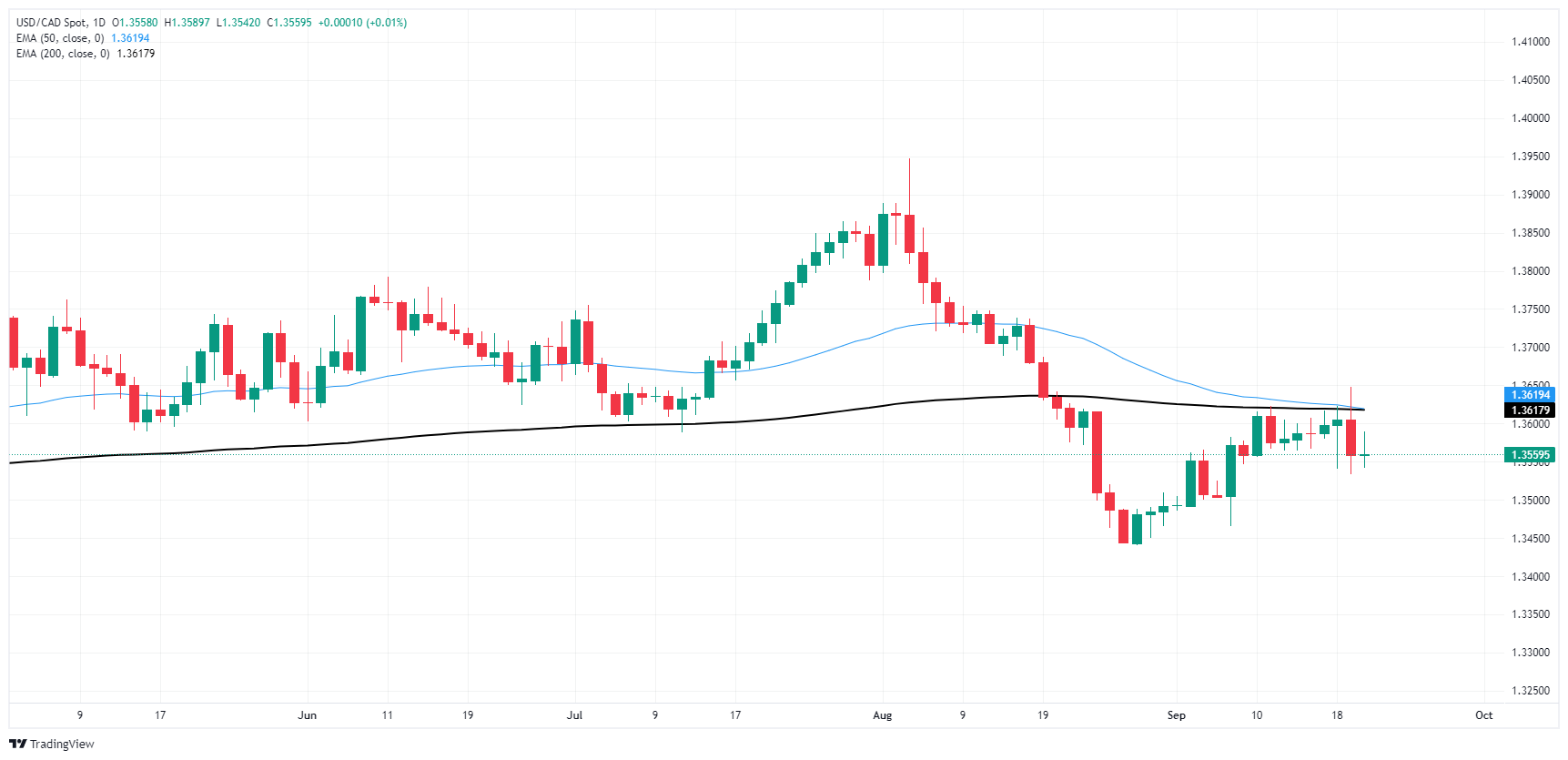- The Canadian Dollar continues to churn in the midrange.
- Canada remains on the back burner after CPI inflation fizzled this week.
- CAD traders are facing a slim data calendar next week.
The Canadian Dollar (CAD) found little underpinning momentum on Friday, and the CAD is poised to wrap up the end of the trading week close to where it started. The Canadian Dollar fell to a three-week low of 1.3650 against the US Dollar (USD), but broad-market Greenback weakness has USD/CAD stumped near 1.3550.
An appearance from Bank of Canada (BoC) Governor Tiff Macklem fizzled on Friday, failing to jumpstart CAD flows as the BoC Governor focused on non-monetary policy musings. Looking ahead to next week, CAD traders are facing down another quiet week with strictly mid-tier data on offer.
Daily digest market movers
- The CAD is cycling familiar territory on Friday, with little directional momentum on either side.
- BoC Governor Macklem made a public appearance, but focused on AI tech and its limited intersectionality with central banking.
- BoC head Macklem will get another kick at the can next week when he speaks at the Institute of International Finance and Canadian Bankers Association Canada Forum in Toronto next Tuesday.
- Markets are still exhausted after splurging in the wake of the Federal Reserve’s jumbo 50 bps rate cut on Wednesday.
- Canadian economic data is thin next week, with only mid-tier data on the docket.
Canadian Dollar price forecast
The Canadian Dollar (CAD) continues to plumb familiar territory on Friday, with little meaningful momentum underpinning the currency. USD/CAD is still cycling just south of the 200-day Exponential Moving Average (EMA) near the 1.3600 handle.
USD/CAD daily chart
Canadian Dollar FAQs
The key factors driving the Canadian Dollar (CAD) are the level of interest rates set by the Bank of Canada (BoC), the price of Oil, Canada’s largest export, the health of its economy, inflation and the Trade Balance, which is the difference between the value of Canada’s exports versus its imports. Other factors include market sentiment – whether investors are taking on more risky assets (risk-on) or seeking safe-havens (risk-off) – with risk-on being CAD-positive. As its largest trading partner, the health of the US economy is also a key factor influencing the Canadian Dollar.
The Bank of Canada (BoC) has a significant influence on the Canadian Dollar by setting the level of interest rates that banks can lend to one another. This influences the level of interest rates for everyone. The main goal of the BoC is to maintain inflation at 1-3% by adjusting interest rates up or down. Relatively higher interest rates tend to be positive for the CAD. The Bank of Canada can also use quantitative easing and tightening to influence credit conditions, with the former CAD-negative and the latter CAD-positive.
The price of Oil is a key factor impacting the value of the Canadian Dollar. Petroleum is Canada’s biggest export, so Oil price tends to have an immediate impact on the CAD value. Generally, if Oil price rises CAD also goes up, as aggregate demand for the currency increases. The opposite is the case if the price of Oil falls. Higher Oil prices also tend to result in a greater likelihood of a positive Trade Balance, which is also supportive of the CAD.
While inflation had always traditionally been thought of as a negative factor for a currency since it lowers the value of money, the opposite has actually been the case in modern times with the relaxation of cross-border capital controls. Higher inflation tends to lead central banks to put up interest rates which attracts more capital inflows from global investors seeking a lucrative place to keep their money. This increases demand for the local currency, which in Canada’s case is the Canadian Dollar.
Macroeconomic data releases gauge the health of the economy and can have an impact on the Canadian Dollar. Indicators such as GDP, Manufacturing and Services PMIs, employment, and consumer sentiment surveys can all influence the direction of the CAD. A strong economy is good for the Canadian Dollar. Not only does it attract more foreign investment but it may encourage the Bank of Canada to put up interest rates, leading to a stronger currency. If economic data is weak, however, the CAD is likely to fall.
Information on these pages contains forward-looking statements that involve risks and uncertainties. Markets and instruments profiled on this page are for informational purposes only and should not in any way come across as a recommendation to buy or sell in these assets. You should do your own thorough research before making any investment decisions. FXStreet does not in any way guarantee that this information is free from mistakes, errors, or material misstatements. It also does not guarantee that this information is of a timely nature. Investing in Open Markets involves a great deal of risk, including the loss of all or a portion of your investment, as well as emotional distress. All risks, losses and costs associated with investing, including total loss of principal, are your responsibility. The views and opinions expressed in this article are those of the authors and do not necessarily reflect the official policy or position of FXStreet nor its advertisers. The author will not be held responsible for information that is found at the end of links posted on this page.
If not otherwise explicitly mentioned in the body of the article, at the time of writing, the author has no position in any stock mentioned in this article and no business relationship with any company mentioned. The author has not received compensation for writing this article, other than from FXStreet.
FXStreet and the author do not provide personalized recommendations. The author makes no representations as to the accuracy, completeness, or suitability of this information. FXStreet and the author will not be liable for any errors, omissions or any losses, injuries or damages arising from this information and its display or use. Errors and omissions excepted.
The author and FXStreet are not registered investment advisors and nothing in this article is intended to be investment advice.
Recommended content
Editors’ Picks

NZD/USD slides below 0.5500 for the first time since March 2020, ahead of RBNZ
NZD/USD has touched a fresh low since March 2020 this Wednesday and looks to extend the downward momentum below the 0.5500 mark ahead of the RBNZ's expected 25 bps interest rate cut decision. The global meltdown on the back of tariffs-led recession fears and escalating US-China trade war continue to weigh on the Kiwi.

AUD/USD slumps to fresh low since March 2020 amid worsening US-China trade relations
AUD/USD dropped to its lowest level since March 2020 after officials confirmed that the US will proceed with a sweeping 104% tariff on Chinese imports starting this Wednesday. Besides the escalating US-China trade war, global recession fears continue to rattle financial markets worldwide and drive flows away from the risk-sensitive Aussie.

Gold price extends its consolidative price move near multi-week low
Gold price remains confined in a range near a multi-week low touched on Monday amid mixed fundamental cues. The widening global trade war and recession fears lead to an extended sell-off in equity markets worldwide. Moreover, bets for more aggressive Fed rate cuts and a weaker USD act as a tailwind for the bullion.

RBNZ set for another interest rate cut amid trade tariff uncertainty
The Reserve Bank of New Zealand is on track to deliver a 25 basis point cut to the Official Cash Rate, bringing down the key policy rate from 3.75% to 3.50% following its April monetary policy meeting on Wednesday.

The Fed is looking at a hefty price level
We are still in thrall to tariffs, the faux-macro “data” driving markets. The WSJ editorial board advised other countries to take their tariffs to zero so that Trump’s “reciprocal” tariffs will have to be zero, too. Cute, but no cigar.

The Best brokers to trade EUR/USD
SPONSORED Discover the top brokers for trading EUR/USD in 2025. Our list features brokers with competitive spreads, fast execution, and powerful platforms. Whether you're a beginner or an expert, find the right partner to navigate the dynamic Forex market.



